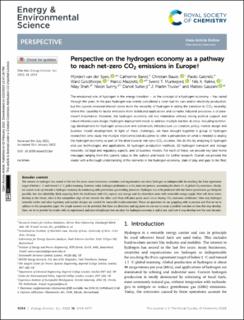| dc.contributor.author | van der Spek, Mijndert | |
| dc.contributor.author | Banet, Catherine | |
| dc.contributor.author | Bauer, Christian | |
| dc.contributor.author | Gabrielli, Paolo | |
| dc.contributor.author | Goldthorpe, Ward | |
| dc.contributor.author | Mazzotti, Marco | |
| dc.contributor.author | Munkejord, Svend Tollak | |
| dc.contributor.author | Røkke, Nils Anders | |
| dc.contributor.author | Shah, Nilay | |
| dc.contributor.author | Sunny, Nixon | |
| dc.contributor.author | Sutter, Daniel | |
| dc.contributor.author | Trusler, J.P. Martin | |
| dc.contributor.author | Gazzani, Matteo | |
| dc.date.accessioned | 2023-02-22T12:51:04Z | |
| dc.date.available | 2023-02-22T12:51:04Z | |
| dc.date.created | 2022-02-02T15:13:27Z | |
| dc.date.issued | 2022 | |
| dc.identifier.citation | Energy & Environmental Science. 2022, 15 (3), 1034-1077. | en_US |
| dc.identifier.issn | 1754-5692 | |
| dc.identifier.uri | https://hdl.handle.net/11250/3053301 | |
| dc.description.abstract | The envisioned role of hydrogen in the energy transition – or the concept of hydrogen economy – has varied through the years. While in the past hydrogen was mainly considered a clean fuel for cars and/or for electricity production, the current renewed interest stems from the versatility of hydrogen and the multiple roles that it can take in the transition to CO2 neutrality, where the common denominator is the capability of tackling emissions from distributed applications and complex industrial processes. However, the hydrogen economy will not materialise without strong political support and robust infrastructure design. This is because hydrogen deployment needs to tackle multiple barriers at once, including technology development for hydrogen production and conversion, infrastructure co-creation, policy and market design and business model development. In light of these challenges, we have brought together a group of hydrogen researchers that span the multiple disciplines involved to give a perspective on the status of the hydrogen economy, and on what is needed to deploy the hydrogen economy as part of the drive towards net-zero-CO2 societies. We do this by analysing (i) hydrogen end-use technologies and applications, (ii) hydrogen production methods, (iii) hydrogen transport and storage networks, (iv) legal and regulatory aspects, and (v) business models. For each of these, we provide key take home messages ranging from the current status to the outlook and needs for further research. Overall, we provide the reader with a thorough understanding of the elements in the hydrogen economy, state of play and gaps to be filled. | en_US |
| dc.description.abstract | Perspective on the hydrogen economy as a pathway to reach net-zero CO<inf>2</inf> emissions in Europe | en_US |
| dc.language.iso | eng | en_US |
| dc.publisher | Royal Society of Chemistry | en_US |
| dc.rights | Navngivelse 4.0 Internasjonal | * |
| dc.rights.uri | http://creativecommons.org/licenses/by/4.0/deed.no | * |
| dc.title | Perspective on the hydrogen economy as a pathway to reach net-zero CO2 emissions in Europe | en_US |
| dc.title.alternative | Perspective on the hydrogen economy as a pathway to reach net-zero CO<inf>2</inf> emissions in Europe | en_US |
| dc.type | Peer reviewed | en_US |
| dc.type | Journal article | en_US |
| dc.description.version | publishedVersion | en_US |
| dc.source.pagenumber | 1034-1077 | en_US |
| dc.source.volume | 15 | en_US |
| dc.source.journal | Energy & Environmental Science | en_US |
| dc.source.issue | 3 | en_US |
| dc.identifier.doi | 10.1039/D1EE02118D | |
| dc.identifier.cristin | 1997042 | |
| dc.relation.project | EC/H2020/691712 | en_US |
| dc.relation.project | Norges forskningsråd: 271498 | en_US |
| cristin.ispublished | true | |
| cristin.fulltext | postprint | |
| cristin.qualitycode | 1 | |

